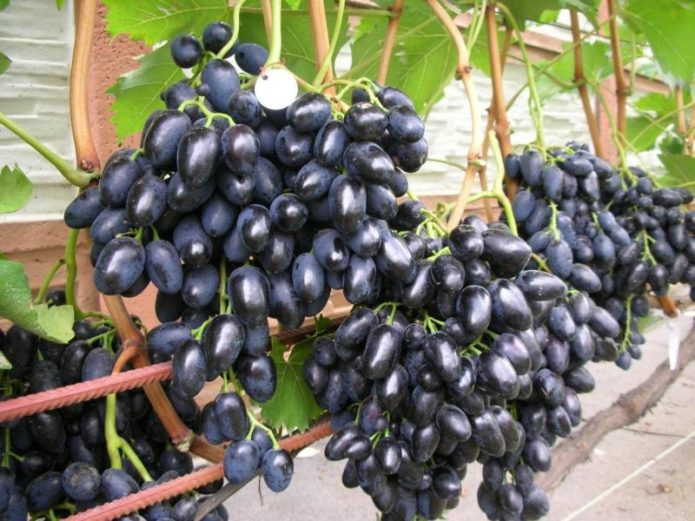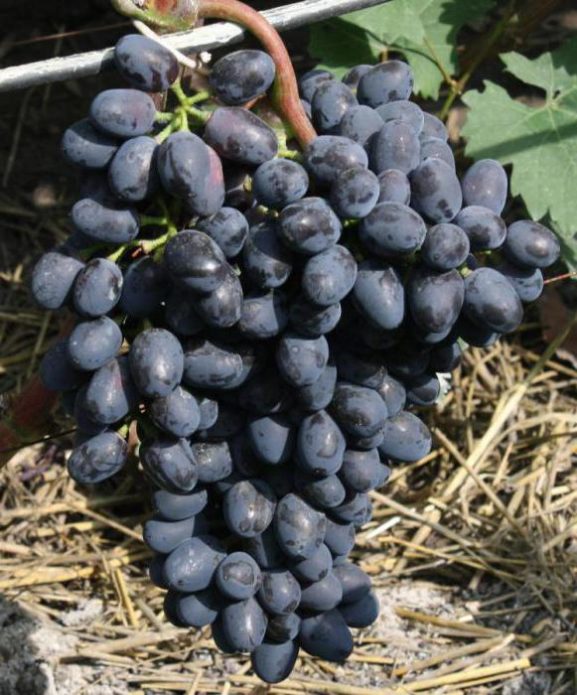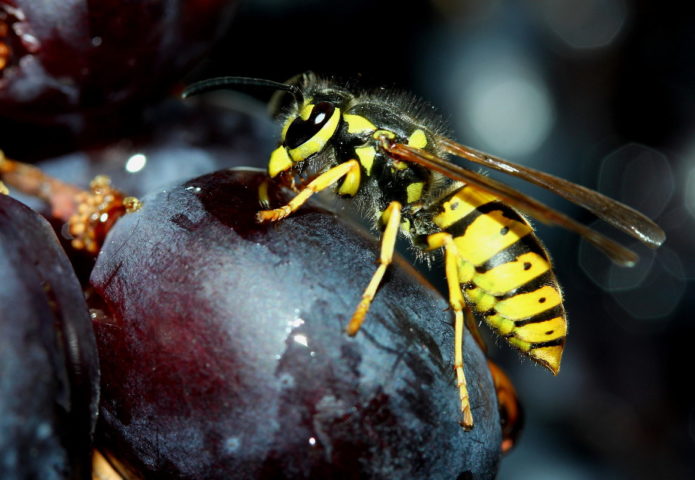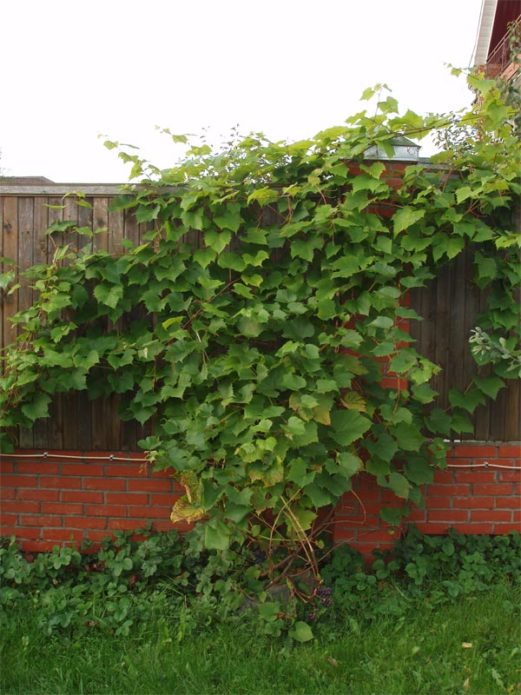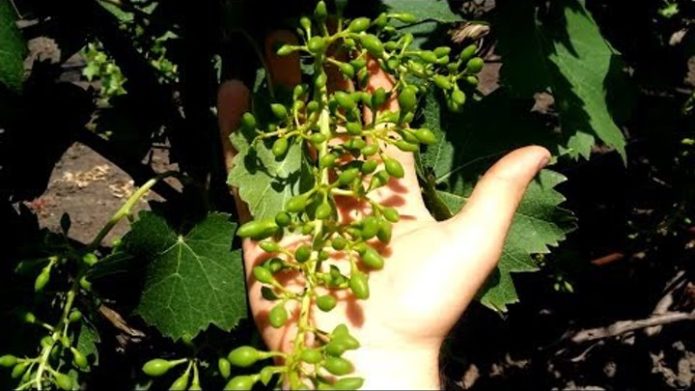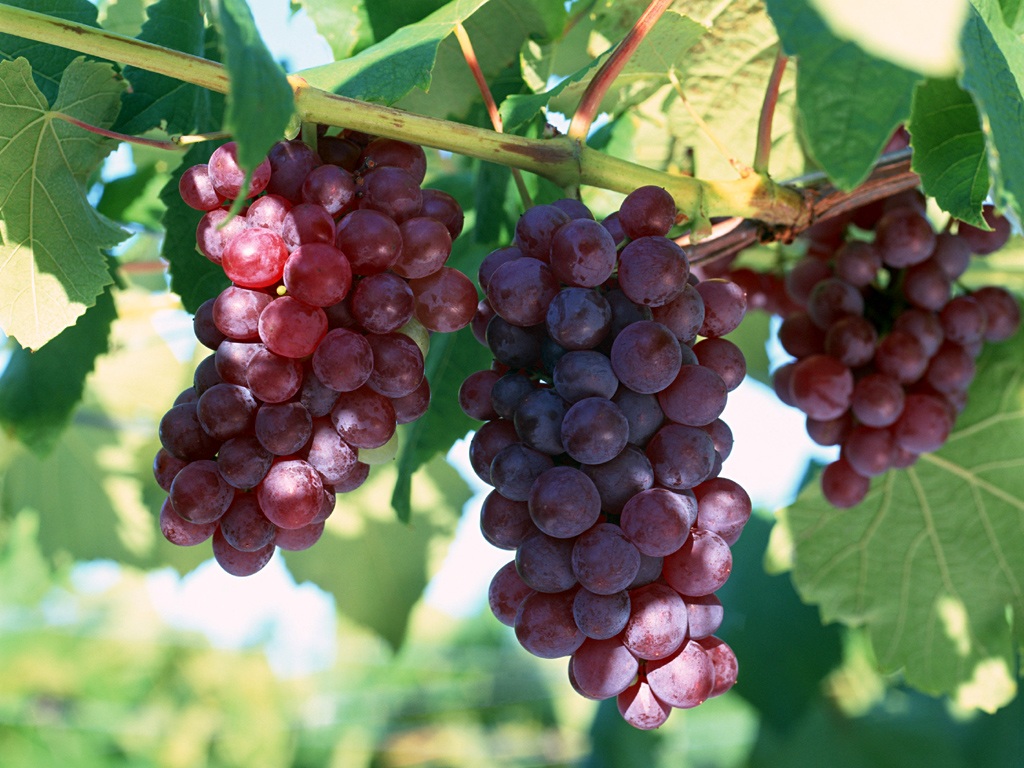Charlie is one of the rather young grape varieties of domestic selection. Although it has not yet been fully explored, growers note its high winter hardiness, good yield, unpretentious care and the ability to grow in various climatic conditions. It is equally suitable both for fresh use and in winemaking, where they successfully obtain products comparable to grapes from the famous Cabernet Sauvignon variety.
Content
Breeding history, description and characteristics of the Charlie grape variety
Charlie grape, also known as Anthracite, appeared recently as a result of the selection work of the Russian wine grower E.G. Pavlovsky and employees of the Kuban University. The name Anthracite, under which it was registered in the State Register of Breeding Achievements of the Russian Federation in 2015, was given to the grapes for the rich, almost black color of the berries. Charlie is obtained by crossing two well-known fine grape varieties: Victoria and Nadezhda AZOS.
Victoria is a variety that has been cultivated since the middle of the last century, it is distinguished by its complex resistance to the vagaries of the weather, coupled with good berries. Nadezhda AZOS is also a middle-aged variety, known for over 40 years, characterized not only by the excellent taste of beautiful large berries, but also by a fairly high resistance to frost and diseases. Charlie acquired from the parental forms all the best that the breeders wanted to convey to him. Before getting on the list of the State Register, he was tested for a whole decade.
As follows from the data of the State Register, the tasting assessment of fresh grapes is 8.4 points. This is a very high score, even against the background of a whole bunch of new grape varieties appearing more and more often. In addition, in the same document it is indicated that Charlie is intended "for horticultural use," but the yield indicators (far from record) are clearly given in terms of industrial use (138.8 kg / ha). In amateur gardens, up to 20 kg of berries are harvested from the bush. This grape is undergoing varietal tests in neighboring countries - Ukraine and southern Belarus. So far there are all indications for cultivating it in different climatic zones.
Charlie bushes of medium height, leaves of the usual five-lobed shape. Shoots ripen perfectly to their full length, and it is noted that this happens long before the end of the growing season: for example, at the latitude of Voronezh, the lignification of the vine ends in mid-August. Such an indicator contributes to the promotion of the variety in regions with a short summer, especially since the berries ripen very early: 105-115 days after the buds awaken. Cuttings take root perfectly: this is the main method of propagation of grapes.
The number of shoots grows very quickly, and it is already normal for young bushes to have up to 30 pieces. The proportion of fruiting shoots is 90–95%. The flowers are bisexual, that is, grapes do not require other varieties of bushes nearby for pollination. The variety is characterized by the ability to tie a very large number of bunches on one shoot - up to 7 specimens, but for normal ripening of the berries, most of them have to be removed, leaving no more than two.
Frost resistance is slightly higher than average: bushes without shelter can withstand temperatures of -25 ° C. Of course, this indicator indicates that the variety is covering, but the vine needs light shelter for the winter in most regions. It is indicated that this grape is not very afraid of recurrent spring frosts: the blossoming leaves, of course, are damaged, but the grapes then quickly recover, just like after hail or heavy rain. In rainy weather, the berries do not deteriorate, and after the onset of sunny days they continue to ripen. However, in case of heavy showers, cracking is quite possible.
Disease resistance is above average, but preventive spraying is required. "Heavy artillery" in the form of powerful chemicals of increased toxicity is not required for this variety.
The first few bunches of grapes are produced the next year after planting. The bunches are large, weighing on average about 800 g, and kilogram specimens are not uncommon, and the record holders can reach up to 2 kg and have a length of up to 40 cm. The shape of the bunch is varied, but more often - conical, the packing of berries is medium loose. Nondescript small berries ("peas") are not found in bunches. The berries stay on the bushes for a long time without shedding. The crop is well transported over any distance.
Charlie's berries are egg-shaped, very large, bluish-black in color, weighing from 5 to 9 g. It is interesting that the juice is practically colorless. The pulp is dense, with a high juice content, characterized by sugar content from 16% to 22% (depending on the degree of ripening) and medium acidity. The berries contain 2-3 seeds, the dense skin does not interfere with the use of grapes.
Experts warn against premature harvest: the berries are colored very early, and the taste gains a full bouquet and sugar content much later.
Many tasters note the nightshade flavor of Charlie berries, which is not liked by everyone, but winegrowers argue that it is characteristic only for unripe berries, as well as for young bushes, this flavor gradually disappears with maturation. The taste of berries also depends on the growing conditions of the bushes. In general, it is rated as pleasant, balanced, but not ideal among table varieties.
The incidence of wasps is changeable: some gardeners say that they practically do not experience problems with these insects, while others necessarily protect the crop with special nets.
Although officially considered a table grape, Charlie is used in a variety of ways. The unique taste of wine from this grape is described, a good juice is made from the berries, they are processed into jam, marshmallow, etc.
Features of planting and growing Charlie grape varieties
Charlie is one of the grape varieties that do not bring much trouble to the owner, so it can be recommended for planting even for an inexperienced summer resident. This is due, first of all, to its increased resistance to diseases and the vagaries of the weather.
Landing
The technique of planting grapes of the variety in question does not differ from the generally accepted one, but for it it is necessary to choose the sunniest place: in partial shade, the quality and quantity of the harvest decreases sharply. In addition, Charlie reacts very badly to drafts. This is not too critical: since its bushes are not very large, tall fruit trees or shrubs can be planted on the sides, and on the north side, the wall of a house, a barn or a blank fence is usually a barrier from the wind.
Spring planting is ideal, but all preparatory operations are performed in the fall.Charlie's bushes do not require a large feeding area, so they often do without even continuous treatment of the site, laying the necessary doses of fertilizers only in the planting pit. They dig a relatively small hole: 60 x 60 x 60 cm is enough, the distance between the bushes may be small - only 1–1.5 m. Therefore, when planting several bushes, it is more convenient to dig a trench.
Filling the pit is traditional: a layer of drainage material (gravel, broken brick, just coarse sand), a layer of fertilizers mixed with the soil (1.5–2 buckets of humus, 300–400 g of azofoska), a layer of clean, good soil. In spring, grapes are planted in a pit so that young roots do not come into contact with fertilizers. The bush is well watered, watering is often carried out during the first year. In the early years it is necessary to loosen the soil and fight with weeds; then the grapes themselves will suppress their growth.
Grape care
The main operations in the cultivation of grapes are well known: watering, feeding, preventive spraying, pruning, shelter for the winter. Watering is required infrequently, their intensity depends on the weather. The soil should be moderately moist, but waterlogging is unacceptable. The need for water in grapes is especially great during the period of intensive fruit growth, and sub-winter watering is also required. Watering is stopped 15–20 days before harvesting.
Top dressing is required from the third year of the bush's life, but they should be done in moderation. Every two years, in early spring or late autumn, one and a half buckets of compost are buried under the bush, annually in the spring - a couple of liters of wood ash. Before flowering and in the first days of berry growth, foliage is sprayed with weak solutions of complete mineral fertilizers, but some experts believe that foliar feeding is not at all mandatory for Charlie.
This variety is not afraid even of such widespread grape diseases as mildew and powdery mildew, it is not affected by rot and anthracnose. But, remembering that “God protects him,” it is still worth spraying it at least once a year with the simplest fungicide for preventive purposes. If it is still far from sap flow, it is easier to use a solution of ferrous sulfate, but if the kidneys are already very swollen, you should take Bordeaux liquid.
The defense against wasps can be limited only to the destruction of the nests discovered; bunches of these grapes are placed in nets only by some summer residents. But if the number of striped predators on the site is large, they can eat Charlie too, so you need to be prepared for this turn of events. Moreover, the berries of this grape must be allowed to hang for a longer time, over time they only become tastier: sugar comes in, nightshade taste goes away.
Pruning of these grapes is not difficult, although for a novice summer resident, this operation is most responsible. It is better to leave the pruning for late autumn, when the foliage will fall and everything will be clearly visible. In early spring, it is worth cutting only shoots that have not overwintered. To make it even easier in the fall, all summer you should break out extra shoots and stepchildren while they are still very small.
The most offensive procedure is the normalization of the crop, when you see how much of it has been set, and you have to destroy most of it immediately after flowering. If you leave more than two bunches on the shoot, they may not mature at all, and it will be difficult for the bushes to prepare for winter. Scheme of autumn pruning of bushes - for 6-8 eyes each shoot, leaving no more than 35 eyes for the whole bush.
For the winter, in most regions, light shelter is required: it is enough, removing the vines from the trellis, to throw branches of coniferous trees on them: until the formation of a snow cover, this should be enough, and snow is the best shelter for grapes. But next to the bush for the winter, one must not forget to lay out the poisoned bait for small rodents, which are very fond of nibbling the grape bark in winter.
Video: Charlie grapes at the end of summer
Advantages and disadvantages of the variety in comparison with similar
Charlie is a large-fruited grape with a dark berry color; in principle, there are not very many such varieties. It is to some extent similar to its "mother" - grapes Nadezhda AZOS, but it has a much greater resistance to various adverse factors. If we digress from the color and try to compare Charlie with other large-fruited early modern varieties, it turns out that there are many examples of grapes with equally beautiful and more delicious berries, but they are usually intended only for fresh consumption. Charlie can be considered both a table and a wine variety at the same time.
Experts highlight many advantages of the variety in question, for example:
- stable good yield;
- low degree of susceptibility to grape diseases;
- increased frost resistance, self-healing after spring frosts;
- unpretentiousness to growing conditions;
- excellent commercial qualities of fruits and their transportability;
- the versatility of the purpose of the crop;
- uniform ripening of berries in bunches;
- the safety of berries on the bushes for a long time.
As disadvantages, growers note:
- unusual taste of berries with a nightshade or even a thorny flavor;
- susceptibility of crops to birds;
- cracking of berries in case of heavy rains.
The high presentation of the bunches makes Charlie one of the favorites of those growers who grow berries commercially. It is a variety recommended for planting on both small personal and large farms.
Video: grower on the state of Charlie's bushes in a troubled year
Reviews
The vine on Charlie's bushes always fully ripens. When testing the newest G.F. there is a point: how the form behaves when overloaded. So all the bunches ripened in Charlie, five days later they ripened only from the control bush with a normal load. The vine is also all clean, without signs of disease. The next year, after overloading, the bush gave quite a good harvest.
Charlie, Charlie ... How Lyme sings. I decided to try today: Nightshade, Nightshade ... There is still a taste of nightshade, there is no escape. Already sweetish, but aftertaste ... True, there is hope, or rather information from the Kherson "Dachnik", that when fully ripe "nightshade" will go away, and if periodically treated with potassium monophosphate, then even earlier.
At the GF. CHARLIE received the first 3 bunches. They ripened completely, despite the rainy summer. To be honest, neither I nor the children liked the taste of PASLEN. As they say, "the taste and color." I'll watch it for another year, and then I'll decide what to do with it.
I have Charlie for 4 years. The main advantages of the variety: very effective appearance, absolute resistance to cracking, is not affected by wasps, excellent vine ripening. For my 56th latitude, the period of real maturity when nightshade leaves is the end of September (this year I kept it until October 10), showed 18Brix. For me, Charlie is a kind of beacon in terms of time, for which it is no longer possible to swim. I hope Dawn Nesvetaya will be early. By the way, Charlie also has a rare taste of nightshade in Cabernet Sauvignon. This gave me the idea to add it to the Friendship and Crystal separation. The dye is cool, it turned out like a rose.
Charlie is a very good strain. Darkened a month ago, pinched a berry, the taste was grassy-nightshade. And finally, ripe. The taste is excellent, sweet with a slight sourness, it's a pity there are few berries left on the signaling, the bush is only two years old. From the rains, some berries began to burst a little, but not fatally. I wanted to plant another bush, but there is no place. Something has to be removed to please Charlie.
Charlie grapes are an example of a universal variety; it is suitable for early consumption of large, beautiful fresh berries, and for technical purposes: making juices, wines, and jams.Its high degree of protection from diseases and pests, as well as its increased frost resistance make it very attractive for cultivation by winegrowers of various skill levels.
